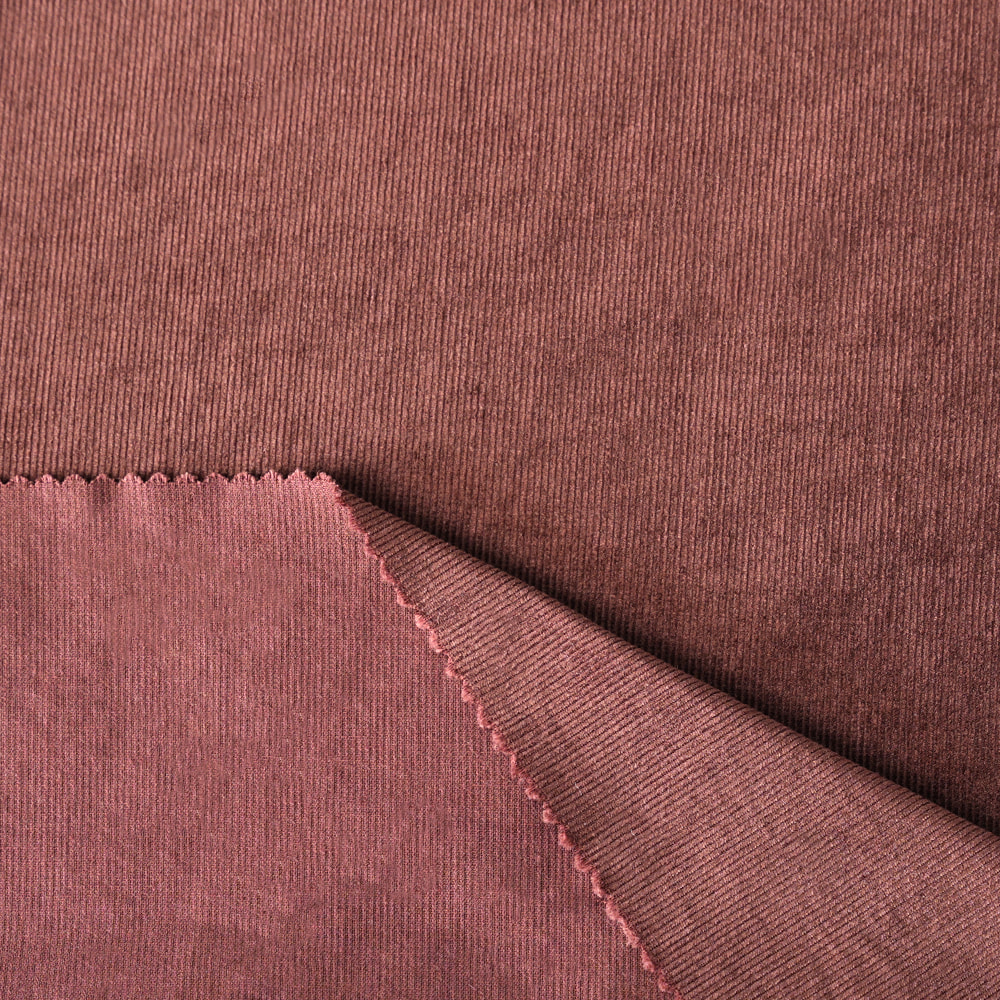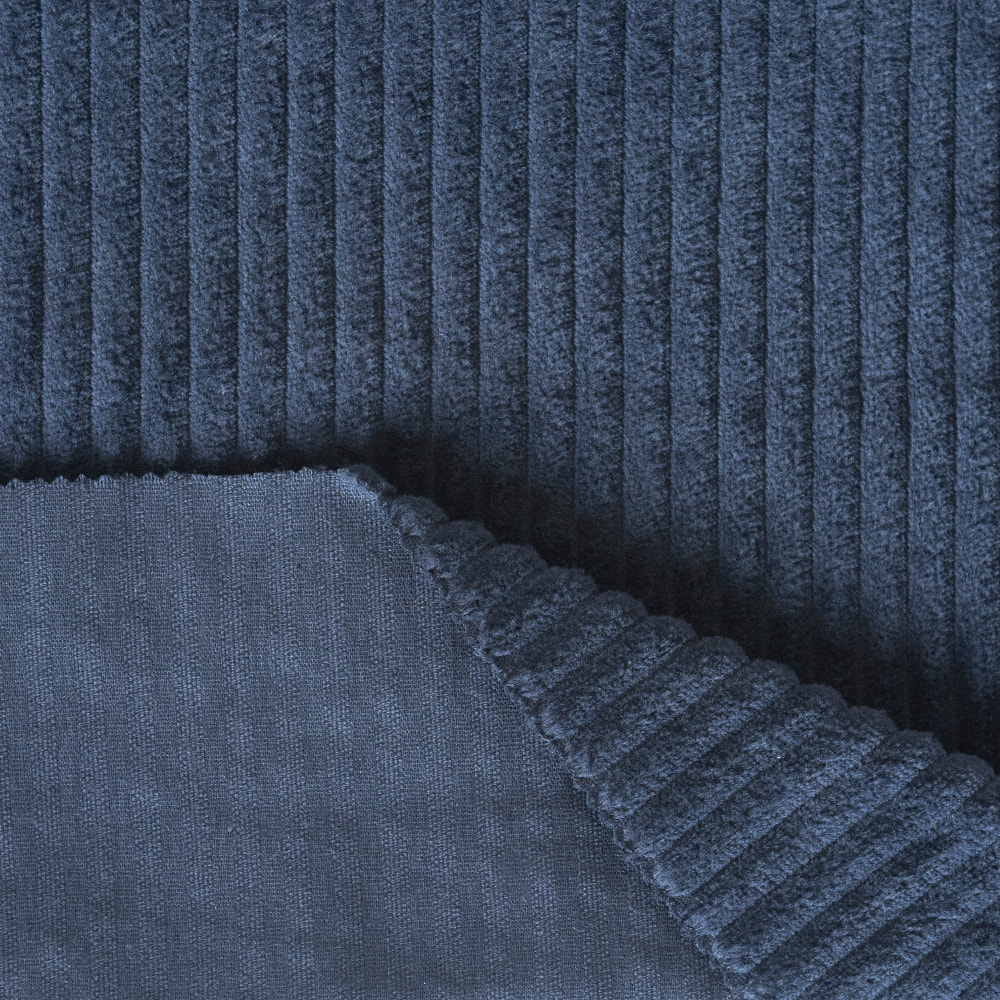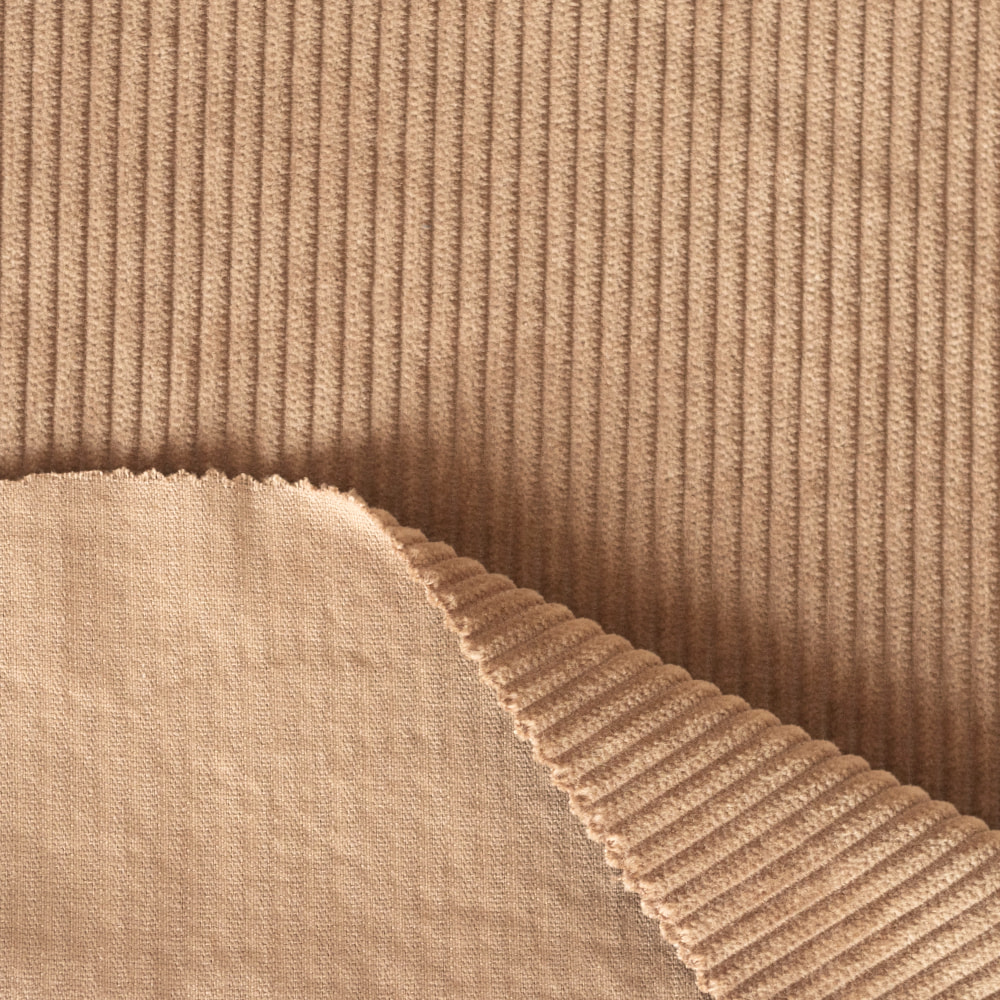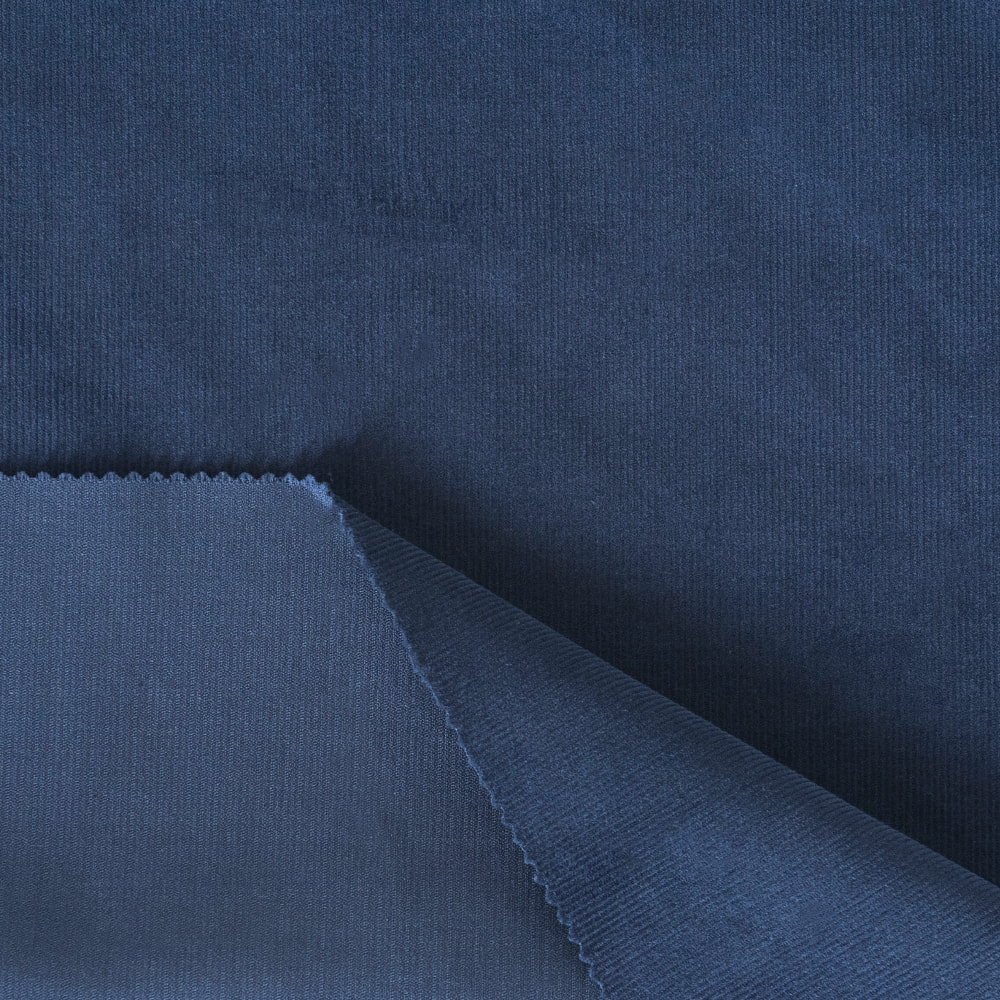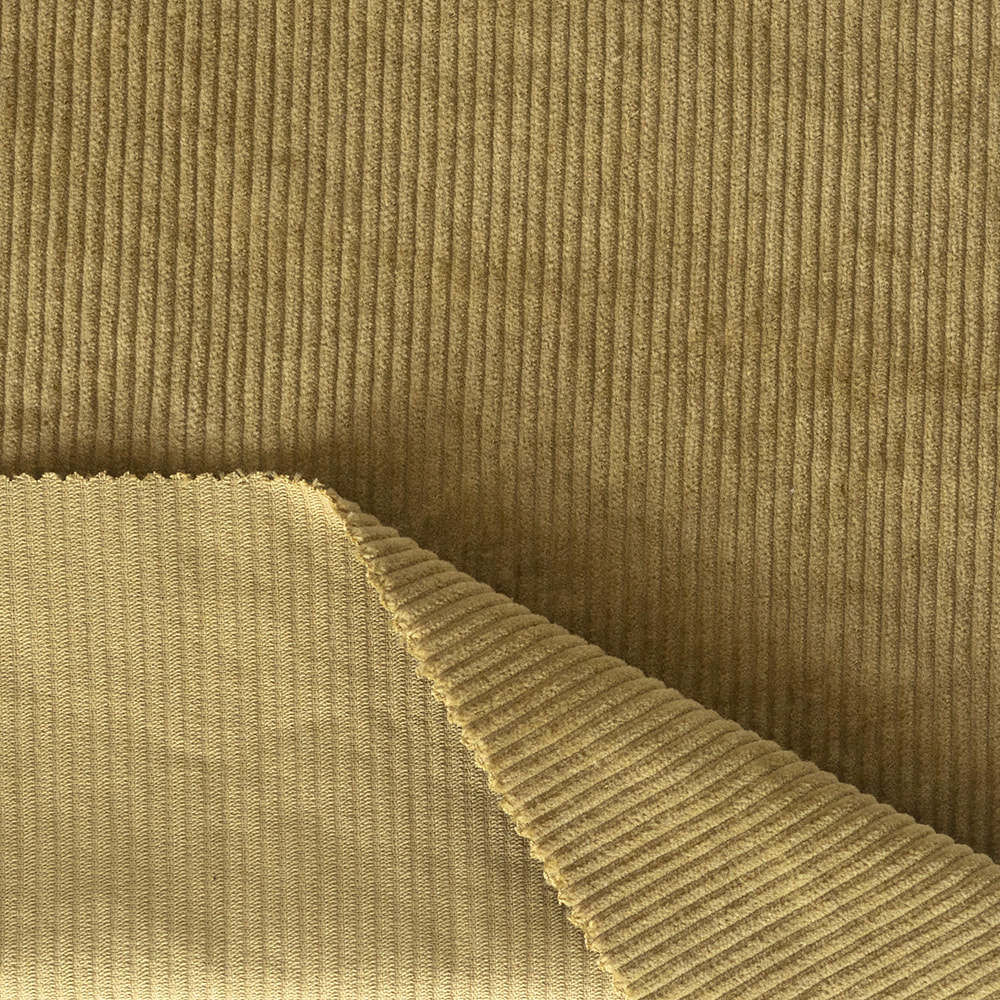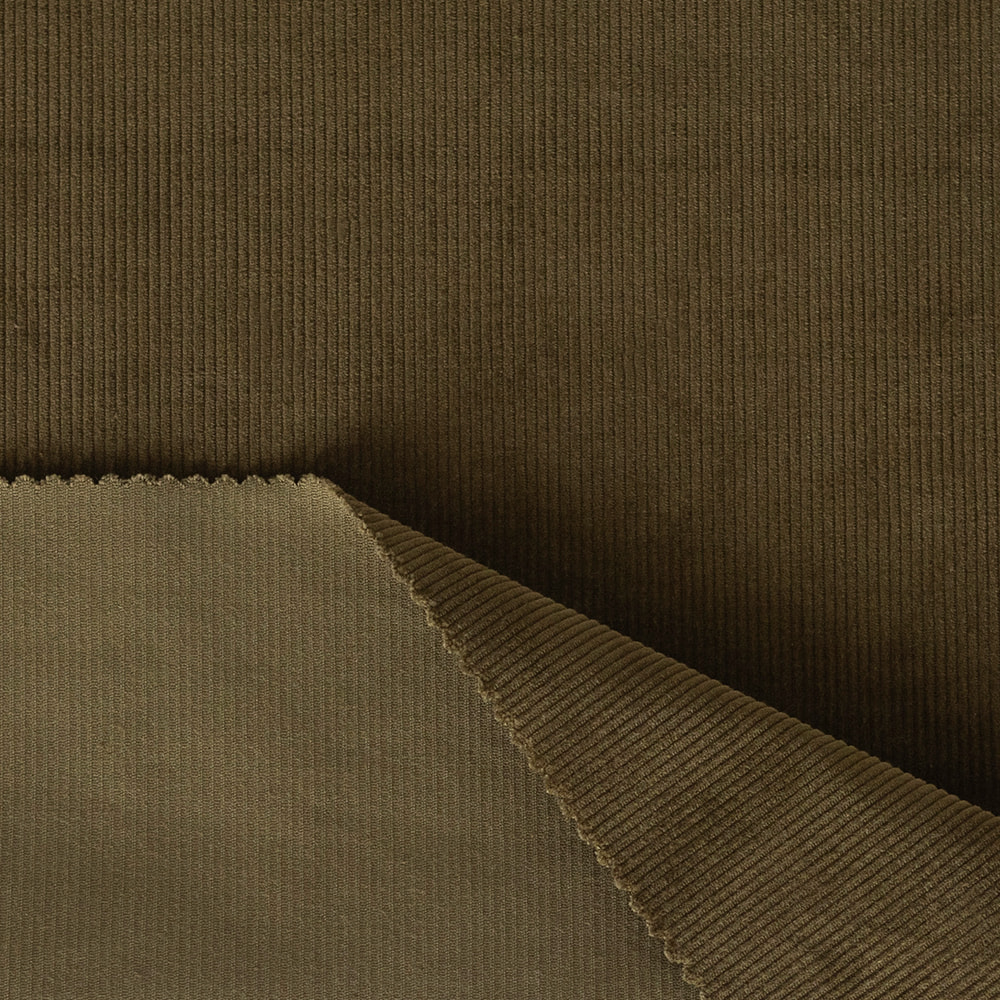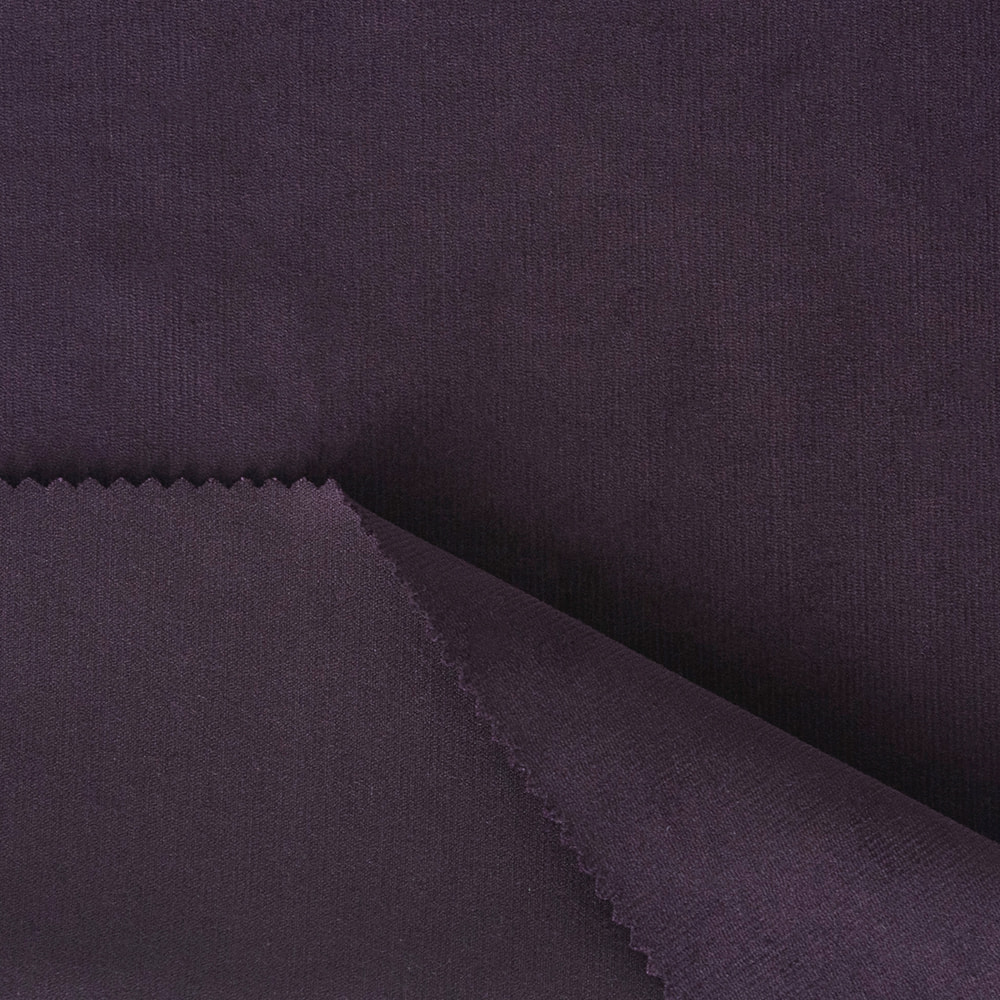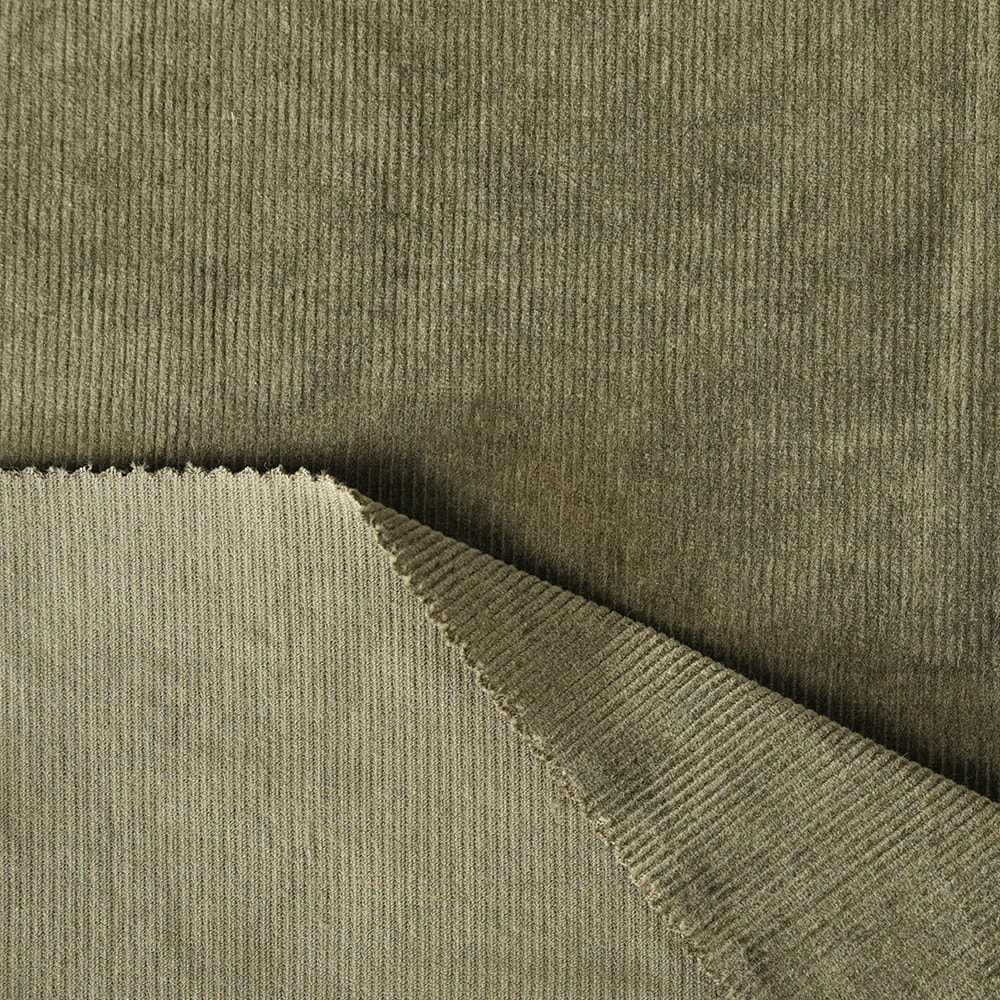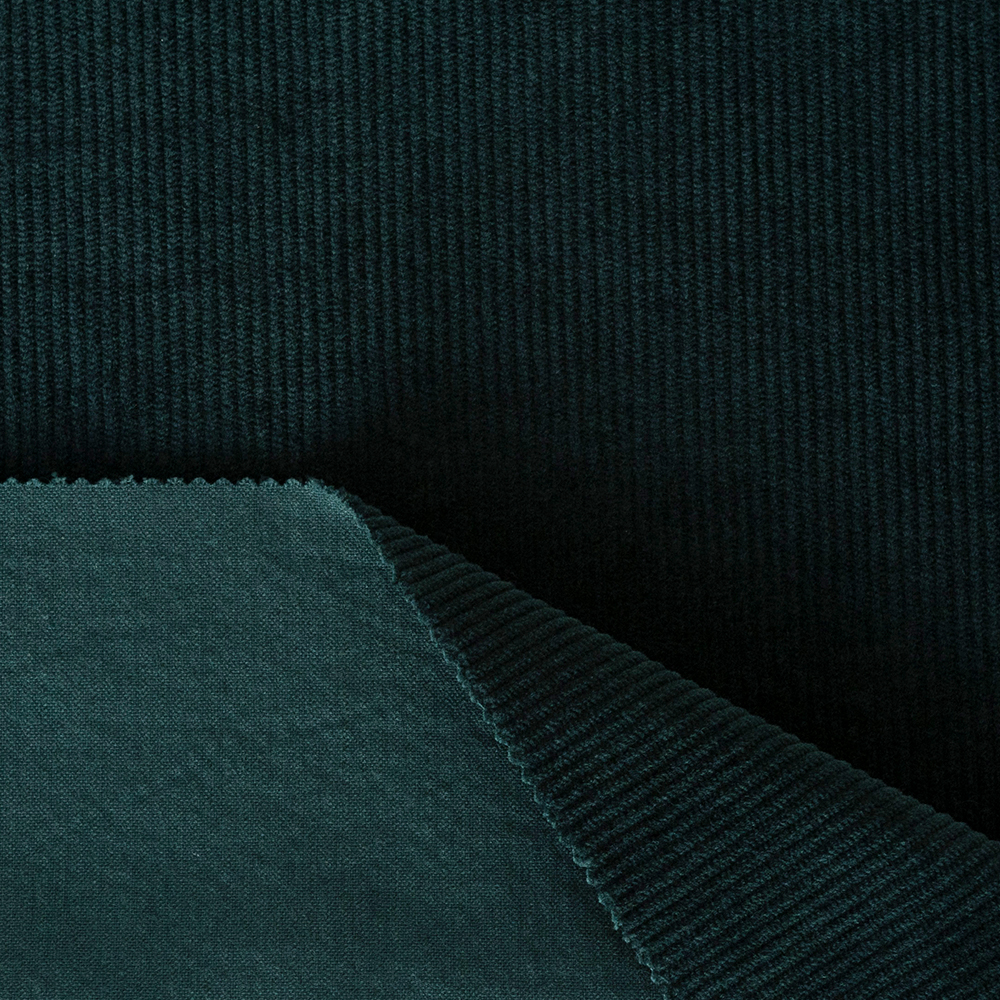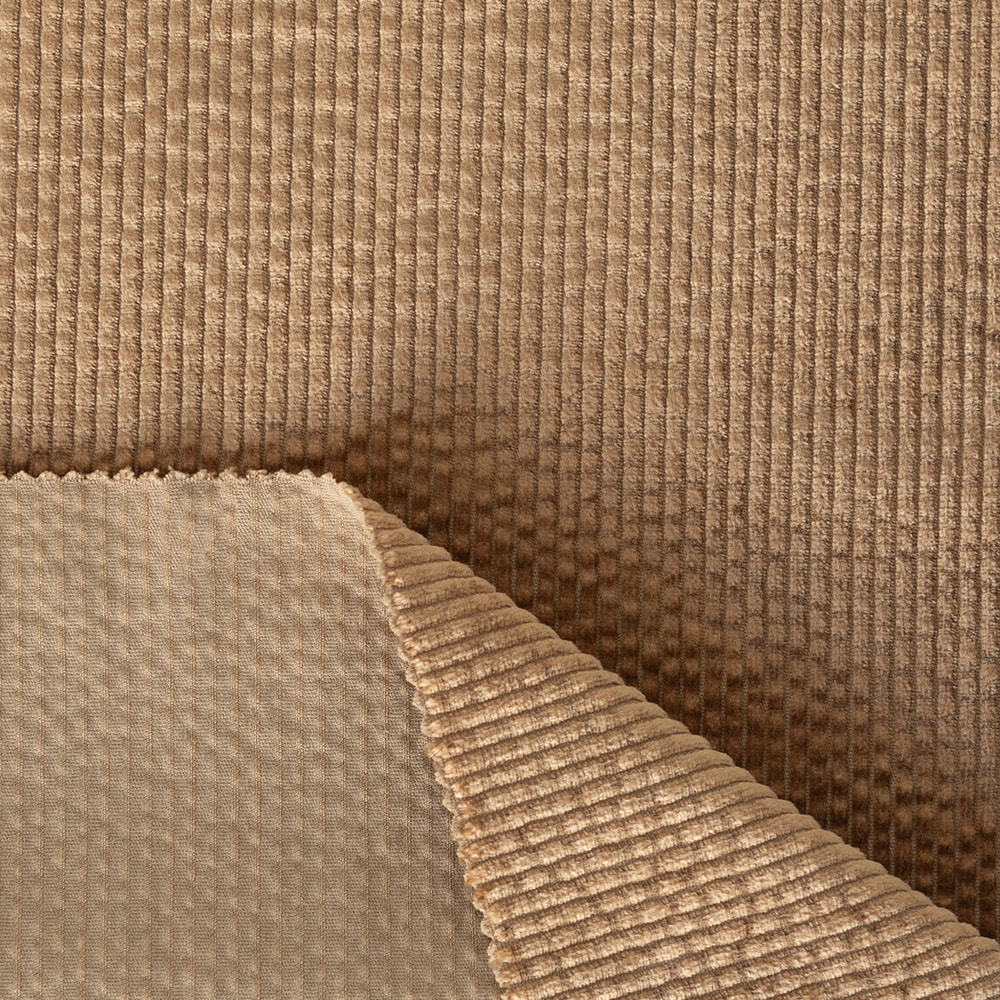Textile Industry Zone, East Hutang Town, Wujin District,213100 Changzhou,China
Introduction
In today’s textile market, innovation and sustainability go hand-in-hand. One fabric that perfectly captures this dual demand is Tencel-Cotton Corduroy. This hybrid textile combines the timeless appeal of corduroy with the softness and eco-consciousness of Tencel fibers. The result is a fabric that not only looks luxurious and feels gentle against the skin, but also supports environmentally responsible fashion and design.
Corduroy has long been admired for its ribbed texture, retro charm, and versatility in both casual and upscale applications. However, traditional cotton corduroy can sometimes fall short in terms of breathability, shrink resistance, or environmental performance. By blending cotton with Tencel—an eco-friendly fiber derived from sustainably harvested wood pulp—manufacturers have created a new generation of corduroy that meets modern expectations for comfort, aesthetics, and sustainability.
The popularity of Tencel-Cotton Corduroy Fabric is steadily rising in the worlds of fashion, home decor, and lifestyle accessories. Designers appreciate its rich texture and vivid dyeability, while consumers love the way it drapes and feels on the skin. From tailored jackets to cozy cushions, this innovative fabric is making its mark across industries.
This article aims to provide a comprehensive overview of Tencel-Cotton Corduroy Fabric, exploring its composition, properties, benefits, and various applications. Whether you're a fashion designer, interior decorator, or conscious consumer, understanding this fabric’s qualities can help you make informed and sustainable material choices.
What is Tencel-Cotton Corduroy Fabric?
Corduroy Fabric: A Classic with Character
Corduroy is a distinctive textile known for its raised ridges or "wales", which run lengthwise across the surface of the fabric. These wales give corduroy its signature appearance and texture. Traditionally made from 100% cotton, corduroy is woven using a cut-pile weave, which creates loops of yarn that are then sheared to produce the soft, velvety ridges.
Corduroy comes in various wale widths—from fine wale (baby cord) to wide wale—each suited to different applications. Its durability and structured feel have made it a staple in workwear, outerwear, and furniture upholstery for decades.
However, while classic corduroy is prized for its texture and vintage aesthetic, it can sometimes feel stiff, warm, or heavy. That’s where fiber blending comes into play.
The Tencel-Cotton Blend: A Match Made in Modern Textiles
Tencel is a brand name for Lyocell fibers produced by the Austrian company Lenzing AG. Derived from sustainably sourced wood pulp, Tencel fibers are known for their softness, breathability, and eco-friendly manufacturing process. When blended with cotton, Tencel adds a silky smoothness and improved moisture management to the final fabric.
The typical blend ratio in Tencel-Cotton Corduroy can vary, but popular configurations include 50% Tencel / 50% Cotton or 60/40 blends, depending on the desired softness, structure, and drape.
Together, these two fibers create a balanced textile: cotton offers strength and a familiar texture, while Tencel enhances the fabric’s softness, flow, and environmental performance.
This blend makes corduroy more wearable year-round, not just as a winter fabric. The Tencel infusion also helps reduce common cotton drawbacks like shrinkage, stiffness, and poor moisture wicking.
The Piece-Dyeing Process: Vibrancy and Flexibility
An important part of producing Tencel-Cotton Corduroy is the piece-dyeing process. In contrast to yarn-dyed or garment-dyed textiles, piece dyeing involves dyeing the entire fabric roll after it has been woven, but before it’s cut and sewn into products.
This method offers several advantages:
Color Consistency: Piece dyeing allows the fabric to absorb dye uniformly, resulting in smooth, rich, and even color tones.
Flexibility: Manufacturers can dye the same base fabric in a wide range of colors, providing designers with more creative freedom.
Sustainability: Many piece-dyeing processes today use low-impact dyes and closed-loop water systems, particularly when dyeing Tencel blends, which absorb dye more efficiently than cotton alone.
The combination of Tencel’s dye affinity and modern piece-dyeing technology means that Tencel-Cotton Corduroy is available in vibrant, long-lasting colors, with better resistance to fading over time.
Tencel-Cotton Corduroy Fabric is a modern reimagining of a classic textile. It merges the nostalgic charm of corduroy with the contemporary demands for softness, breathability, and sustainability. Through thoughtful fiber blending and smart dyeing techniques, this fabric is well-positioned to meet the needs of today’s conscious consumers and creative professionals.
Properties and Characteristics of Tencel-Cotton Corduroy Fabric
Tencel-Cotton Corduroy Fabric offers a well-rounded blend of functionality, comfort, and aesthetic appeal. Each component—corduroy’s signature ribbed texture, cotton’s natural strength, and Tencel’s smoothness—contributes to a fabric that is both visually rich and physically inviting. In this section, we’ll explore the core properties that define the performance and feel of this hybrid material.
Texture and Appearance
At first glance, Tencel-Cotton Corduroy exhibits the distinctive ribbed surface that corduroy is known for. These raised lines or “wales” create a three-dimensional texture that reflects light differently depending on angle, giving the fabric a soft sheen and depth of color. The wale count—ranging from narrow (baby wale) to wide (jumbo wale)—affects both the appearance and intended use of the fabric.
Thanks to the addition of Tencel, the fabric has a noticeably softer, silkier surface than traditional corduroy. Tencel fibers are naturally smooth and round in cross-section, so when they are woven into the pile structure of corduroy, they reduce the roughness typically associated with coarser cotton yarns.
Visually, Tencel’s superior dye uptake also enhances the richness and evenness of the color. This makes Tencel-Cotton Corduroy ideal for both vibrant and muted palettes, lending a luxurious, modern aesthetic to garments and interiors alike.
Durability and Comfort
Corduroy has a reputation for toughness, and the cotton component of this blend maintains that structural integrity. It withstands regular wear and tear, making it suitable for daily use in both fashion and upholstery contexts.
But where Tencel-Cotton Corduroy truly excels is in its balance between durability and comfort. Traditional corduroy can feel stiff or bulky, especially when used in colder seasons. By integrating Tencel, the fabric gains improved pliability and flexibility. This not only enhances comfort for wearers but also gives designers greater freedom in crafting flowing silhouettes and relaxed fits.
Additionally, Tencel fibers exhibit high tensile strength, both wet and dry, which contributes to the fabric’s long lifespan. The blend resists pilling, fraying, and structural distortion, even after multiple washes, making it a smart investment for both apparel and home textiles.
Breathability and Moisture-Wicking
One of the standout features of Tencel fibers is their excellent moisture management. Tencel has a unique ability to absorb moisture efficiently and then release it quickly into the air. When combined with cotton—another naturally breathable fiber—the result is a corduroy that feels cool and dry against the skin.
This is a significant upgrade from traditional 100% cotton or polyester-based corduroys, which can sometimes trap heat or sweat. Tencel-Cotton Corduroy regulates body temperature more effectively, making it suitable not just for autumn and winter, but also for transitional seasons.
Whether used in clothing or home furnishings, this enhanced breathability helps prevent the buildup of odors and reduces the need for frequent laundering, contributing to both personal comfort and fabric longevity.
Drape and Hand Feel
“Hand feel” refers to how a fabric feels when touched, while “drape” describes how it hangs and flows on the body or surface. These two qualities are especially important in fashion and upholstery design.
Tencel-Cotton Corduroy offers a remarkably soft hand, due in large part to the Tencel content. Unlike pure cotton corduroy, which can feel rugged or coarse, this blend is smooth and almost velvet-like, with a touch that is often compared to silk or brushed suede.
When it comes to drape, the fabric falls more gracefully than traditional corduroy. Tencel’s finer fiber diameter and natural fluidity allow the fabric to conform to body contours or hang elegantly from furniture, depending on the application. This makes it especially desirable for garments that require movement—such as wide-leg trousers, midi skirts, and relaxed-fit blazers—as well as decorative drapery and cushion covers.
Additional Characteristics
Color Retention: Tencel’s strong affinity for dyes results in more vibrant and longer-lasting color compared to pure cotton corduroy. This makes the fabric ideal for fashion collections and interior products where color vibrancy is critical.
Low Static and Wrinkle Resistance: Tencel fibers naturally resist static buildup and wrinkles better than cotton, adding to the fabric’s usability in travel and everyday wear.
Hypoallergenic Qualities: Tencel is gentle on sensitive skin due to its smooth fiber surface and lack of chemical residues. When blended with cotton, it maintains this hypoallergenic profile, making the fabric suitable for baby clothing, sleepwear, and bedding.
Reduced Shrinkage: Thanks to Tencel’s dimensional stability and the blend with pre-treated cotton, this fabric tends to shrink less in the wash compared to pure cotton corduroy. This ensures a better fit and appearance over time.
Tencel-Cotton Corduroy proves that performance and aesthetics don’t have to be mutually exclusive. Its combination of tactile appeal, practical wearability, and eco-conscious sourcing positions it as a next-generation textile for a wide variety of uses.
Benefits of Tencel-Cotton Blend
Blending Tencel with cotton creates a textile that embodies both innovation and tradition. This powerful combination improves upon the strengths of each fiber, delivering a fabric that is not only more comfortable and versatile but also more sustainable. In this section, we’ll explore the key benefits that make Tencel-Cotton Corduroy a standout material in the modern textile industry.
Sustainability Aspects: Tencel’s Eco-Friendliness
One of the most compelling advantages of Tencel is its environmental sustainability. Produced from renewable wood sources such as eucalyptus, beech, and spruce, Tencel fibers are created through the Lyocell process, which is widely considered one of the most environmentally responsible fiber production methods in the world.
Here are several reasons why Tencel is considered a green fiber:
Closed-loop manufacturing: The solvents used to produce Tencel are recycled in a closed-loop system that recovers and reuses more than 99% of the chemicals, dramatically reducing environmental emissions.
Low water usage: Compared to conventional cotton, Tencel production uses significantly less water and land resources, making it more sustainable over time.
Biodegradability: Tencel fibers are completely biodegradable and compostable under industrial, home, soil, and marine conditions.
FSC and PEFC certifications: The wood used in Tencel production is often sourced from responsibly managed forests, certified by the Forest Stewardship Council (FSC) or Programme for the Endorsement of Forest Certification (PEFC).
By blending Tencel with cotton, manufacturers reduce the environmental burden typically associated with 100% cotton production—particularly water and pesticide usage—while still maintaining cotton’s natural softness and familiarity. For designers and consumers seeking eco-friendly materials without compromising performance, Tencel-Cotton Corduroy is an excellent choice.
Enhanced Softness Compared to Traditional Corduroy
Tencel fibers have a smooth surface and fine structure, which contribute to a significantly softer texture compared to traditional cotton corduroy. This softness is especially noticeable in direct-to-skin garments such as:
Shirts and blouses
Loungewear and sleepwear
Children's clothing
Linings and casual pants
This enhanced softness elevates the tactile experience of corduroy, making it more suitable for all-day wear and close contact with sensitive skin. It also helps mitigate the rough or stiff feel that some people associate with heavier cotton corduroy fabrics.
Importantly, this softness does not come at the expense of strength. Tencel fibers are strong and resilient, ensuring that the fabric remains durable while feeling gentle and luxurious.
Improved Color Retention Due to Piece-Dyeing
One of the most noticeable benefits of Tencel in this blend is its excellent dye uptake. Tencel has a high affinity for dye molecules, which means it absorbs colors more efficiently and uniformly than cotton or synthetic alternatives. When Tencel-Cotton Corduroy undergoes piece-dyeing, the result is a fabric with:
Richer, deeper tones
Greater uniformity across the surface
Increased resistance to fading over time
This makes Tencel-Cotton Corduroy particularly valuable in the fashion and home décor markets, where color integrity is crucial. Whether dyed in deep autumnal hues or bright spring pastels, the colors remain vibrant even after multiple washes and exposure to light.
Furthermore, piece-dyeing allows for greater flexibility in manufacturing, as large fabric batches can be dyed in various shades depending on seasonal trends or customer demand. For sustainable brands, using eco-friendly dyes with Tencel further enhances the green credentials of the final product.
Reduced Shrinkage
Cotton is well known for its tendency to shrink when washed, especially if not pre-treated or pre-shrunk. Tencel, on the other hand, offers excellent dimensional stability, meaning it resists shrinking and stretching even when wet.
When blended with cotton, Tencel helps minimize overall fabric shrinkage, providing a more stable and predictable performance in the final garment or textile product. This reduced shrinkage is particularly valuable in fashion, where sizing consistency is critical for customer satisfaction.
The result is a fabric that:
Maintains its shape after laundering
Fits better over time
Requires fewer alterations or sizing adjustments
Holds up well under repeated use and care cycles
This stability also supports longer product lifespans, further aligning with the principles of sustainable design and slow fashion.
Additional Functional and Aesthetic Advantages
Beyond the primary benefits mentioned above, Tencel-Cotton Corduroy also offers a variety of secondary advantages that contribute to its growing popularity across industries:
Wrinkle Resistance
While 100% cotton fabrics can wrinkle easily, Tencel contributes natural wrinkle resistance to the blend. This makes the fabric more suitable for travel clothing, workwear, and applications where a crisp, smooth appearance is desired with minimal ironing.
Better Drape
Tencel's fluid nature enhances the overall drape of the corduroy, making it more flattering when used in tailored garments. The fabric follows the body’s lines rather than standing stiffly away, which is particularly useful in modern, minimalist clothing designs.
Lower Static and Pilling
Tencel reduces the risk of static cling and fabric pilling, common issues with synthetic blends or lower-grade cotton. The smooth fiber surface contributes to a clean, high-end look even after prolonged use.
Hypoallergenic and Skin-Friendly
As mentioned earlier, Tencel is naturally hypoallergenic. It does not trap bacteria or irritants, making it an excellent choice for people with sensitive skin or allergies.
Consumer Appeal and Market Relevance
From a marketing and branding perspective, offering products made from Tencel-Cotton Corduroy allows brands to:
Emphasize sustainability and eco-certification
Deliver a superior tactile experience
Offer products that are low-maintenance and long-lasting
Cater to consumers who value style, comfort, and ethics equally
In a market increasingly driven by conscious consumerism, this fabric aligns with key values such as environmental awareness, product transparency, and wellness. Brands that incorporate Tencel-Cotton Corduroy into their collections are seen as forward-thinking and responsible, especially among Gen Z and millennial buyers.
The benefits of Tencel-Cotton Corduroy go far beyond its luxurious feel or trendy appearance. This fabric reflects a broader shift in the textile industry—toward materials that perform well, feel great, and leave a smaller footprint on the planet.
Whether you're designing next season's fashion collection or sourcing eco-friendly materials for home décor, Tencel-Cotton Corduroy offers a well-rounded solution that meets the aesthetic, functional, and environmental expectations of today’s market.
Applications of Tencel-Cotton Corduroy Fabric
Tencel-Cotton Corduroy is not just a technical innovation—it is a material that adapts beautifully across industries. Its aesthetic charm, superior softness, and sustainable qualities make it a desirable choice in fashion, interior design, and accessories. In this section, we will explore how this fabric is used across various applications, demonstrating its versatility and practical appeal in today’s market.
Fashion Apparel
Corduroy has long been a staple in autumn and winter fashion, but Tencel-Cotton Corduroy elevates its relevance across seasons due to its breathability and improved drape. Designers increasingly use this fabric in garments that balance structure and softness.
Jackets and Coats
Corduroy jackets made from the Tencel-Cotton blend are warm yet lightweight. The fabric's velvety touch adds a premium feel, while its durability makes it suitable for outerwear that faces the elements. Blazers, trench-style coats, and cropped jackets benefit from the fabric’s ability to hold shape without stiffness.
Pants and Trousers
Corduroy trousers have made a strong comeback in recent fashion cycles. Tencel-Cotton Corduroy adds a modern twist to this classic look by offering a more fluid drape, enabling tailored fits and relaxed silhouettes alike. Wide-leg pants, high-waisted trousers, and flared styles made from this blend offer both comfort and style.
Skirts and Dresses
With its elegant sheen and structured ribbing, this fabric is ideal for skirts and dresses that need shape without stiffness. A-line skirts, pleated midis, and pinafore dresses work particularly well with Tencel-Cotton Corduroy, especially in rich jewel tones or muted neutrals.
Shirts and Blouses
While traditional corduroy may be too stiff for shirting, the softness of Tencel makes lightweight versions of this fabric suitable for casual and smart-casual shirts. The breathability of the fabric allows for year-round wear, while the texture adds interest to minimalist designs.
Children’s Wear
Soft, non-irritating, and highly breathable, Tencel-Cotton Corduroy is an excellent material for baby and children’s clothing. Overalls, pants, and rompers made from this fabric are comfortable, durable, and gentle against sensitive skin.
Home Decor
Tencel-Cotton Corduroy’s tactile richness and color depth make it an attractive choice for a wide range of interior applications. It combines durability with elegance, offering a refined alternative to traditional upholstery and decorative fabrics.
Upholstery
Furniture upholstered in Tencel-Cotton Corduroy brings warmth and texture to living spaces. Sofas, chairs, and ottomans benefit from the fabric’s plush surface, while its strength ensures long-lasting use. Because the fabric resists pilling and fading, it retains its luxurious look over time, even in high-traffic areas.
Cushions and Throw Pillows
Corduroy cushions offer a soft contrast to smoother textiles like linen or leather. The distinctive wale pattern and rich color options allow decorators to layer visual texture into their schemes. Tencel’s dye affinity ensures that colors remain vibrant season after season.
Curtains and Drapes
The enhanced drape of Tencel-Cotton Corduroy makes it perfect for full-length curtains and drapery. It hangs beautifully, blocks light effectively, and adds a cozy sophistication to bedrooms, living rooms, and home offices.
Blankets and Throws
Lighter versions of this fabric can be used to create stylish and functional throws. These are not only warm and inviting but also easy to care for and sustainably produced—a key selling point for conscious consumers.
Accessories
Fashion and interior designers aren’t the only ones embracing this material—Tencel-Cotton Corduroy is also making its mark in the accessories market. Its balance of softness, resilience, and style lends itself to creative uses beyond clothing and furniture.
Bags and Backpacks
Corduroy bags made with this blend are stylish, tactile, and sturdy. From everyday totes to mini backpacks, these accessories benefit from the fabric’s structure and visual appeal. The fine ridges add subtle character without the need for extra embellishment.
Hats and Caps
From baseball caps to bucket hats and berets, Tencel-Cotton Corduroy brings warmth and fashion-forward texture to headwear. Because the fabric holds shape well without feeling heavy, it’s comfortable and flattering across seasons.
Footwear Accents
While not a full footwear material, corduroy panels or linings in boots, sneakers, and slippers add a stylish twist. The softness of Tencel makes it suitable for shoe interiors, ensuring a comfortable fit.
Tech Accessories
Innovative designers are using corduroy fabric to cover laptop sleeves, phone pouches, and even tablet cases. Tencel-Cotton Corduroy provides a soft, protective barrier while offering a visually appealing and tactile surface.
Custom and Artisan Applications
With the rise of small-batch and artisanal textile production, Tencel-Cotton Corduroy is becoming a preferred choice for handcrafters and bespoke designers. Whether it’s used for embroidered wall hangings, handmade journals, or boutique pet accessories, the fabric offers a unique combination of practicality and beauty.
Seasonal and Thematic Uses
Thanks to its thermal properties and lush appearance, corduroy is often associated with colder months. However, Tencel’s cooling effect and lightweight versions of the fabric allow for year-round applications. Pastel-dyed versions work beautifully in spring collections, while rich browns, navy, and forest greens dominate in fall and winter.
Seasonal uses include:
Back-to-school uniforms and fashion
Holiday gift items like scarves or pouches
Spring layering garments such as overshirts and light jackets
Autumn home updates through cushion covers and drapes
Why Designers and Consumers Love It
The adoption of Tencel-Cotton Corduroy is not just a matter of technical utility. Creatives and consumers alike are drawn to its multifaceted appeal:
Designers love the wide range of available weights, the ease of dyeing, and the elevated texture that corduroy brings to collections.
Consumers appreciate the softness, sustainability, and easy care—especially those who want to reduce their impact without sacrificing style.
Retailers value its versatility across categories, allowing for broad merchandising—from fashion and accessories to lifestyle and home décor.
Tencel-Cotton Corduroy is truly a fabric for all seasons and all sectors. From the runway to the living room, from a child’s outfit to an office chair, it delivers consistent value in both performance and aesthetics. As consumer demand shifts toward eco-conscious and experience-driven products, the adaptability of this fabric ensures its continued relevance in fashion, home, and beyond.
Comparison with Other Corduroy Fabrics
As Tencel-Cotton Corduroy gains popularity, it is increasingly important to understand how it compares to other commonly used types of corduroy. Traditional corduroy fabrics—typically made from 100% cotton or polyester blends—have long been valued for their warmth, durability, and textured appearance. However, these older materials often fall short in areas like sustainability, softness, and modern performance. In this section, we’ll explore a detailed comparison between Tencel-Cotton Corduroy, Cotton Corduroy, and Polyester Corduroy, highlighting their advantages, disadvantages, and best-use scenarios.
Cotton Corduroy vs. Tencel-Cotton Corduroy
Cotton corduroy has long been the standard in corded fabrics. Made entirely from natural cotton fibers, this version is soft, breathable, and widely available. However, when Tencel is introduced into the blend, the fabric is elevated in several key ways.
Softness and Comfort
100% Cotton Corduroy tends to be heavier and can feel stiffer, especially when new. It requires washing and wear to soften over time.
Tencel-Cotton Corduroy offers immediate softness and a silky hand feel. Tencel’s smooth fiber structure enhances comfort, especially in garments that are worn close to the skin.
Drape and Fit
Cotton corduroy is structured and holds its shape well but can lack flexibility, making it better for rigid silhouettes.
Tencel-Cotton Corduroy drapes more naturally. It has a gentle fluidity, which improves garment fit and allows for more contemporary, relaxed tailoring.
Shrinkage and Care
Cotton is prone to shrinking when washed and dried, especially if not pre-shrunk during manufacturing.
Tencel reduces overall shrinkage in the blend, making Tencel-Cotton Corduroy easier to maintain over time with less risk of size distortion.
Color Retention
Pure cotton tends to fade after repeated washes, especially with darker dyes.
Tencel absorbs dye more evenly and holds color longer, particularly when the fabric is piece-dyed. This results in richer, more vibrant garments.
Environmental Impact
Cotton production, unless organic, is resource-intensive—especially in terms of water and pesticide use.
Tencel, produced through the eco-friendly Lyocell process, significantly reduces water and chemical use. Blending it with cotton lessens the environmental footprint of the final product.
Best Uses
Cotton Corduroy is best for traditional, structured garments like classic trousers, jackets, and workwear.
Tencel-Cotton Corduroy excels in modern fashion, loungewear, soft tailoring, and skin-contact garments.
Polyester Corduroy vs. Tencel-Cotton Corduroy
Polyester corduroy offers another alternative, especially in mass-market or budget-focused apparel. While it comes with some advantages in terms of cost and durability, it lacks the natural feel and sustainability of newer blends like Tencel-Cotton.
Feel and Texture
Polyester Corduroy often has a synthetic touch and less breathability. Though strong and wrinkle-resistant, it can feel plasticky and retain odors.
Tencel-Cotton Corduroy has a luxurious, breathable, and skin-friendly texture. It is hypoallergenic and moisture-wicking, promoting better comfort for longer wear.
Durability
Polyester is highly durable, resistant to tearing, and retains its shape well. However, it is prone to pilling over time.
Tencel-Cotton Corduroy is also durable but benefits from Tencel’s resistance to pilling and shrinkage. It is strong enough for daily use while offering a more natural look and feel.
Moisture Management
Polyester does not absorb moisture well, often causing discomfort in warm or humid environments.
Tencel naturally wicks moisture away from the body, keeping wearers cooler and more comfortable.
Environmental Considerations
Polyester is derived from petroleum and is not biodegradable. It contributes to microplastic pollution during washing.
Tencel is made from renewable wood pulp and is biodegradable, making it a far more environmentally responsible choice.
Aesthetic and Style
Polyester corduroy may appear shinier and less refined, which can be a drawback in premium fashion or interior design.
Tencel-Cotton Corduroy offers a matte finish with a sophisticated luster that enhances the wale texture of corduroy.
Cost and Market Segment
Polyester corduroy is generally cheaper, making it suitable for high-volume, budget-conscious products.
Tencel-Cotton Corduroy is positioned in the mid- to high-end market, offering better performance and aesthetics for discerning consumers.
Best Uses
Polyester Corduroy is suitable for inexpensive uniforms, fast fashion, and home décor that doesn’t prioritize natural materials.
Tencel-Cotton Corduroy is ideal for premium fashion, eco-conscious designs, and elevated home textiles.
Use Case Scenarios
To illustrate these differences further, here are a few realistic use-case comparisons:
Work Uniforms: Polyester corduroy may be chosen for affordability and high durability, though it lacks breathability.
Vintage-Inspired Jackets: Cotton corduroy remains a classic option, especially in structured styles.
Modern Casualwear or Eco-Fashion: Tencel-Cotton Corduroy is ideal for consumers looking for softness, movement, and sustainability.
Premium Upholstery: Tencel-Cotton Corduroy brings sophistication to interior settings with its smooth touch and color fastness.
Consumer Trends Driving the Shift
Today’s consumers are more conscious of both sustainability and sensory experience. They demand:
Softer, skin-friendly materials
Fabrics that perform under diverse conditions
Transparency in sourcing and production
Biodegradable or recyclable materials
Tencel-Cotton Corduroy aligns perfectly with these expectations. Unlike polyester, which often raises concerns about environmental and health impacts, or pure cotton, which may lack modern features, this blended fabric is positioned as the next-generation corduroy.
The evolution of corduroy is a reflection of the textile industry's larger transformation. While cotton and polyester still dominate many areas, Tencel-Cotton Corduroy is emerging as a superior alternative—one that bridges comfort, sustainability, and style.
It offers a balanced solution for designers, manufacturers, and consumers seeking high-performance materials with a softer environmental impact. Whether chosen for fashion, interiors, or accessories, it sets a new benchmark in how we experience and interact with corduroy fabrics.
Tencel-Cotton Corduroy Fabric is a contemporary textile that blends the best of two natural fibers: Tencel™ Lyocell and cotton. This innovative fabric combines the rich texture of traditional corduroy with the exceptional softness, breathability, and eco-friendliness of Tencel. As the fashion and textile industries move toward sustainable and high-performance materials, this fabric has gained significant attention for its unique balance of comfort, aesthetics, and environmental responsibility.
What Makes It Special?
Corduroy, traditionally known for its signature ribbed surface or "wales," is created through a special weaving process that forms raised ridges across the fabric. In the Tencel-Cotton variant, these ridges take on a new life—softer to the touch, smoother in appearance, and gentler on the skin. The Tencel fibers enhance moisture management, breathability, and color retention, while cotton contributes to strength and structure.
Additionally, this fabric is piece-dyed, which means the entire woven fabric is dyed after construction. This method results in deeper, more consistent colors and gives manufacturers the flexibility to respond to design demands with smaller dye lots and better resource control.
Key Properties and Benefits
Texture & Appearance: Luxuriously soft with a velvety touch and fluid drape, making it ideal for both fashion and home applications.
Durability & Comfort: Strong yet flexible, the fabric holds up well to wear and washing without compromising on comfort.
Breathability: Tencel fibers wick moisture away from the skin, keeping the wearer cool and dry.
Color Retention: The piece-dyeing process and Tencel’s absorbent nature allow for vibrant, long-lasting colors.
Low Shrinkage & Pilling: The blend significantly reduces issues often associated with pure cotton or polyester fabrics.
From a sustainability standpoint, Tencel stands out as one of the most eco-friendly fibers on the market. Derived from responsibly managed forests, Tencel is produced using a closed-loop process that recycles nearly all water and solvents used. When combined with cotton—especially organic or BCI (Better Cotton Initiative) certified—it creates a fabric with significantly lower environmental impact.
Practical Applications
Tencel-Cotton Corduroy is highly versatile:
Fashion Apparel: Jackets, trousers, skirts, and dresses benefit from its softness and modern drape.
Home Decor: Upholstery, cushions, and curtains made with this fabric offer tactile comfort and rich texture.
Accessories: Hats, tote bags, and backpacks utilize the fabric’s structure and aesthetic appeal.
This blend is especially favored in sustainable fashion circles and by brands focused on high-quality, long-lasting garments with a lower environmental footprint.
Comparison with Traditional Corduroy
When compared to other types of corduroy:
Versus Cotton Corduroy: Tencel-Cotton is softer, more breathable, and more colorfast, with less shrinkage and better drape.
Versus Polyester Corduroy: It’s more breathable, biodegradable, and skin-friendly, though polyester may still offer superior water resistance and lower cost.
Overall, Tencel-Cotton Corduroy offers a superior sensory experience and aligns with growing consumer demand for sustainable and ethical textiles.
Care and Maintenance
Caring for Tencel-Cotton Corduroy is relatively simple:
Wash in cold or lukewarm water using gentle detergents.
Avoid high heat in drying to prevent shrinkage; air-drying is ideal.
Iron on a low to medium setting if needed, preferably on the reverse side.
Store in cool, dry places, away from direct sunlight to preserve color and texture.
With proper care, garments made from this fabric maintain their beauty and performance over many uses.
Sustainability and Future Outlook
Tencel’s biodegradability, closed-loop manufacturing, and responsible sourcing make it a top choice for sustainable fashion. The addition of cotton, when sourced responsibly, complements the eco-profile without compromising performance.
As sustainability becomes a priority across fashion, interiors, and lifestyle products, the demand for Tencel-Cotton Corduroy is expected to grow. Innovations in dyeing methods, fiber blending, and textile finishes are likely to further enhance its appeal, making it a fabric of the future.
Tencel-Cotton Corduroy fabric exemplifies how traditional textile forms can be reimagined through innovation and sustainability. It merges the timeless charm of corduroy with the performance and eco-consciousness of modern fibers. Whether you’re a designer, manufacturer, or consumer, this fabric offers the perfect balance of style, comfort, and responsibility—marking a new era for corduroy in the textile world.
